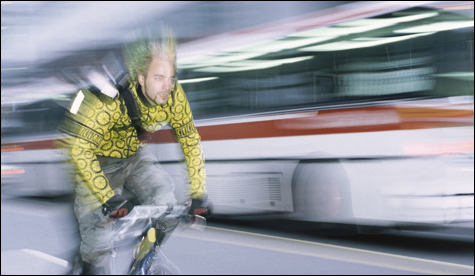
DEFENSE! Don't get by the bus. |
No matter what reason you ride a bicycle in Boston — whether you're a tree-hugger doing your part to save the environment, an outdoor-sports enthusiast, or just a license-free commuter (either by choice or at the urging of the local authorities) — you've probably realized that this city and its decrepit roads aren't very bike friendly. The dangers of urban biking are everywhere: potholes, smog, endless construction, confusing routes, car doors, hordes of college students . . . the list goes on and on. Yet the price of public transportation continues to rise, global warming worsens, and parking becomes increasingly rare, sending more and more people back to their bikes to get around. Biking in the city can be intimidating, but luckily there are tons of products to make your environmentally friendly urban commute safer and smoother.
Basic improvements
If you don't already have them, stock up on basic bicycle safety gear — helmets, flashing LED lights (front and rear, to avoid being doored), and a rear-view mirror. Even though there are few new bike-safety products on the market, existing ones (like helmets and lights) are becoming more comfortable, lightweight, and efficient. These things are especially important in an urban environment where roads are rough, traffic is relentless, and cyclists must learn to ride defensively to prevent injury.
Bud Durand, manager of Cambridge Bicycle, near MIT, says there’s no excuse for cyclists going without basic safety gear, especially helmets. "They're inexpensive, less than a pair of sneakers, and they save your life," says Durand, who points out that college students in particular are reluctant to wear helmets. "We'll ask them whether they're paying $120,000 for their education, and then whether they'd like to protect their investment."

Know how to adjust your helmet properly. The chin strap should be snug without causing discomfort, and the helmet should ride low on your forehead. Add pads inside if you need a tighter fit. If you ride in the dark, pick up extra reflectors for the back of your bike and a piece of reflective clothing, like a vest, arm bands, or a belt. Durand emphasizes that although a mere three percent of riding is done at night, an alarming 50 percent of all bicycle accidents occur after sundown.
Let ’em know you’re coming
Boston drivers love their horns, but why should cyclists miss out on the fun? Making noise in traffic is part of being a Bostonian. The battery-operated, 105-decibel MegaHorn (with a two-tone siren so potent it's used by police and security forces) cuts through the sounds of auto congestion, making it the perfect noisemaker for emergency situations when a single "ping" from a brass bell won't suffice. Other products, such as the Delta Airzound bike horn, can go as loud as 115 decibels but offer volume control for everyday use. Also, unlike the MegaHorn, the Delta can be easily recharged with a bicycle pump. Drivers aren't always aware of the cyclists around them, so do your part to change that. It might save you from being hit by a door . . . or worse.
Clearing the air
A smog mask covers half of your face with hypo-allergenic Neoprene, filtering out dangerous air pollutants such as exhaust fumes, nitrogen oxides, and hydrocarbons, and helping you to breathe easier. Because people who exercise outdoors (especially bicyclists) breathe quickly and deeply, they are more likely to be irritated by smog, resulting in annoying cold-like symptoms. Masks with replaceable filters make it possible for bikers with sensitive respiratory systems to enjoy cruising around the city streets, and protect everyone else from developing unpleasant lung conditions. While the stretchy, perforated masks may look like something a Ninja surgeon would wear, they're actually quite comfortable and practical, letting moisture out while keeping toxins from getting in. Oh, and since they’re available in prints such as flames and dragons, they're totally badass. Wear them with a menacing snarl.
Where in the world . . . ?
A global positioning system isn't just for spoiled teens and soccer moms in SUVs any more — they're now for spoiled teens and soccer moms on bikes as well. GPS, more often used for navigating mountain trails, may seem a bit over-the-top for urban biking, but if you really want to bring your bike into the 21st century and avoid getting lost, these pricey navigation aids can do the trick. Just stick one on your handlebars and the easy-to-read LCD screen will ensure that you'll find your destination without having to deal with any tricky maps. Though they use the same technology and are as accurate as GPS systems for cars, bike navigation systems are shatter-resistant, waterproof, and more compact. And while GPS can be especially helpful to cyclists who are new to the city, seasoned urban cyclists can also benefit from additional features: some of these gadgets can tell you your speed, heart rate, and a 12-hour weather forecast.
Stop, thief!
An important part of establishing a safe riding routine is knowing that your bicycle will still be there at the end of the day. In addition to an array of heavy-duty, water-resistant locks, bike-accessory makers are now creating high-tech, multi-tasking lock, chain, and alarm combinations. Just think: if only Pee-wee Herman had a lock/chain/alarm combo back in 1985, his entire Big Adventure could have been avoided. So rather than scouring the country for your stolen bicycle, lock it up with a loud, irritating alarm.
Bike studies
Classes can be an easy and fairly cheap way to learn about stay safe during your daily commute. If you're a total beginner, check out the Bicycle Riding School in Somerville's Davis Square. They'll teach you the basics that you were too scared to learn as a child, and without the humiliating training wheels.